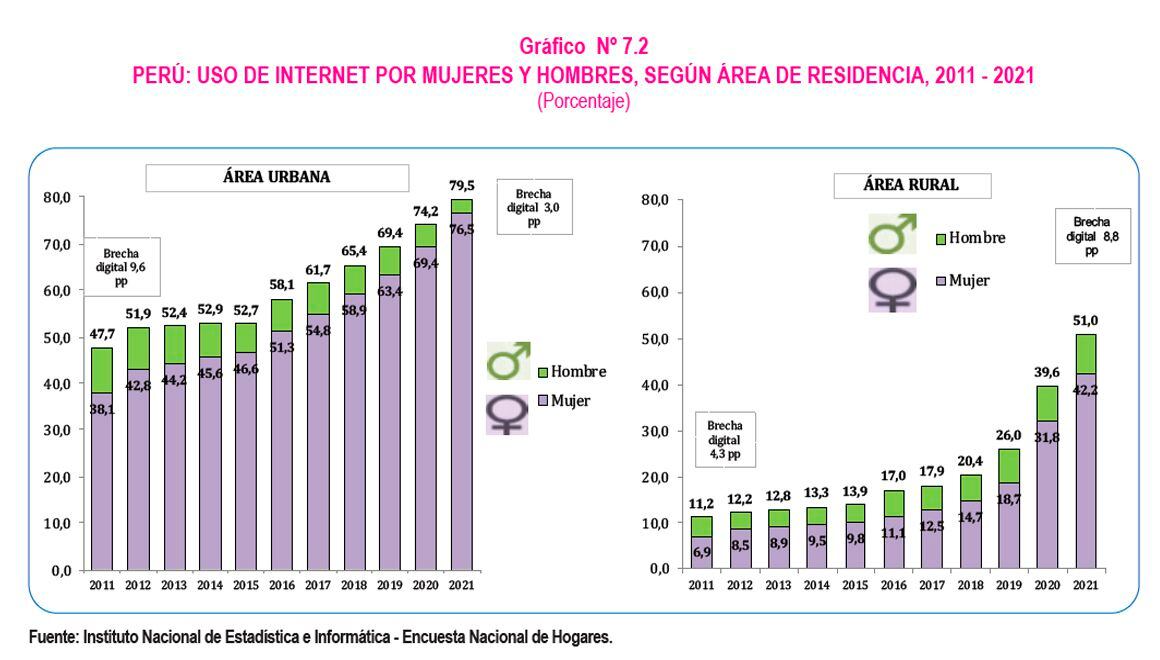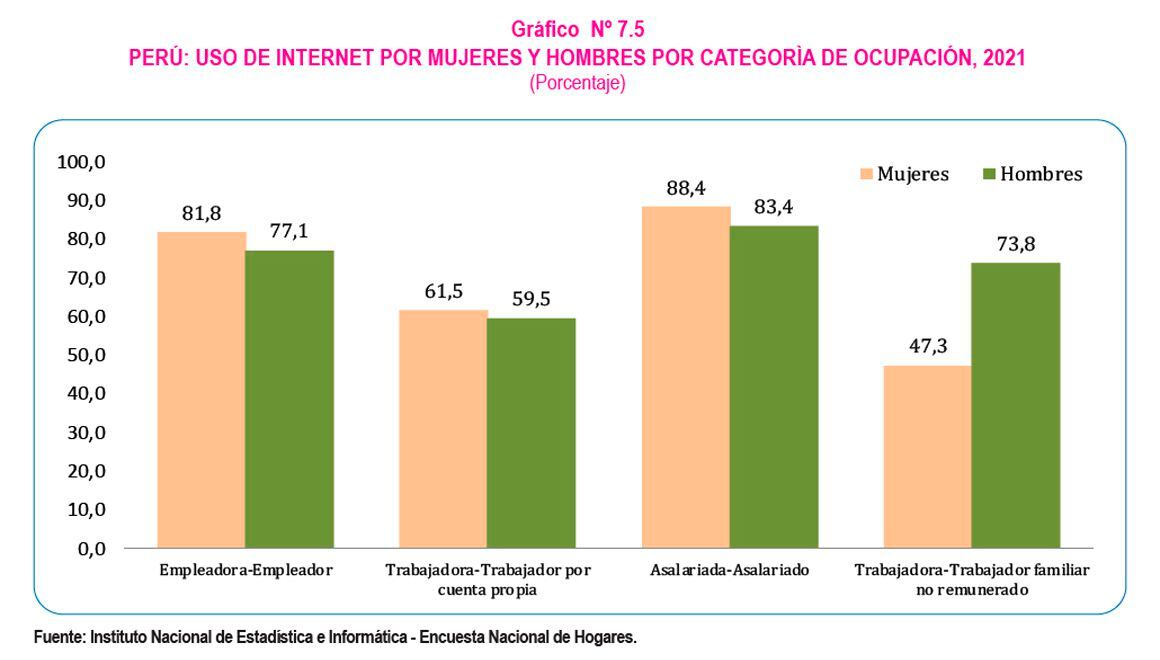If something characterizes our time it is the Internet use for everything: to buy from anywhere on the planet, watch series or movies on the bus, take classes without leaving home, work remotely, do some paperwork. That is, an endless list of activities.
In addition, the COVID-19 pandemic also highlighted the need to access the Internet; However, how many people can count on this technology? How much progress has been made in equal access between men and women?
READ ALSO: What are “digital robots” and why are they so important for companies?
According to the National Institute of Statistics and Informatics (INEI), although the volume of Internet user population has increased considerably in recent years, the percentage of women who use the Internet is still 3.4 percentage points (pp) below the men. And it’s not just about numbers.
The book Gender gaps 2022. Progress towards equality between women and men it takes into account the digital gap that mainly affects Peruvians. And it is that inequalities do not only occur in access to equipment and the Internet. There is also inequality in the origin of the information, in the availability of content and in the identity of the people who broadcast it.
By 2021, the difference of 3.4 percentage points between men and women has been progressively reduced since 2011, when the difference was 7.8 percentage points. But, despite this considerable reduction, there are other spaces where the differences remain or have been accentuated.
READ ALSO: Minors spend a total of two months a year connected to a screen

For example, when it comes to evaluating the situation according to the area of residence, the gap widens in the rural area: from a difference of 3 percentage points (pp) in the urban area it goes to 8.8 pp. A distance that has been increasing for 12 years, as can be seen in the table.
This same difference is repeated according to the ethnic condition. Indigenous women and men access the Internet in 39.5% and 50.8%, respectively, while non-indigenous women and men do so in 76.4% and 78.0%, respectively. According to the INEI, “indigenous women living in rural areas face the disadvantages of remoteness, the lack of accessible means of transportation and communications, and multiple discriminations rooted in ethno-racial inequalities”.
How are these figures shown by the INEI to be understood? For Jurgita Sarkovaite, Manager of Experience Design, at Neo Consulting, the digital divide that exists between genders is also quite consistent with the divide that exists in economic activity.
READ ALSO: The four most common risks that children and adolescents are exposed to on the Internet
“Access to technology is related to the fact that women actually have less economic power, a lower percentage, let’s say, of paid work. So, naturally there is a limit to the access to technology”explained in communication with Trade. But, the difference goes beyond having technological equipment. There is also a social aspect.
Following the information from INEI, the specialist explains that there is a worrying phenomenon regarding the activities of women in rural areas, where the connection is also limited. “In the economic activity they carry out, normally, women have slightly more traditional roles and that also limits access to technology, to the availability of time after the purchasing power to be able to use this”he explained. A shared look from Flora Tristán.
Liz Meléndez, executive director of the organization, indicated to this newspaper that although it is true that women and men tend to go hand in hand in access to education, there is a time when this situation changes for women, mainly because they assume roles reproductive and care
READ ALSO: Your internet is already 4G and 5G: what is 6G and why will it be so important in the future?
“We believe that it is necessary to carry out research to study in depth this scissors effect that women experience. For example, a few months ago Flora Tristán and the Institute of Peruvian Studies conducted a survey that found that in 82% of Peruvian households women are in charge of doing domestic and care work. It was also diagnosed that women invest 112% more of their time in doing these tasks”indicated.

On the other hand, Sarkovaite warns of a second gap around the use given to technology, such as content generation, which could be explained because the technology sector is dominated by men. “I think that is no secret, and so something super important is that when you are designing digital solutions, you are designing the technology, you must think about the different types of users, and you must think about how different people, in different contexts, they use this technology and test with this type of user”he detailed.
The gaps that generate inequalities cannot be bridged on their own. It takes a lot of work. As the specialists have pointed out, the problem does not only lie in a matter of access to the digital world, the management and use of digital tools must also be taken into account. This whole situation becomes more difficult for women in a context of discrimination.
READ ALSO: Peruvians spend more than 3 hours a day on the Internet. How much time do you spend online?
On the one hand is the infrastructure. According to Sarkovaite, Peru is a country of strong contrasts and in urban areas it can be a reference in the region, “But there are also more systematic, more structural gaps that have to be worked on, and the State and private companies have to collaborate to address those gaps”.
He commented that the pandemic pushed digitization, especially of services. But there is still a lot to work on. In this sense, Meléndez stated that the State should not only promote policies that promote adequate access to the Internet.
“Training and digital literacy programs must also be carried out to guarantee good use and management. Especially in populations with a special condition of vulnerability, such as women, indigenous populations, children, older adults, among others”he explained. And it is that the world is increasingly digital and many Peruvians run the risk of being left behind.
Source: Elcomercio
I have worked in the news industry for over 10 years. I have a vast amount of experience in writing and reporting. I have also worked as an author for a number of years, writing about technology and other topics.
I am a highly skilled and experienced journalist, with a keen eye for detail. I am also an excellent communicator, with superb writing skills. I am passionate about technology and its impact on our world. I am also very interested in current affairs and the latest news stories.
I am a hardworking and dedicated professional, who always strives to produce the best possible work. I am also a team player, who is always willing to help out others.

:quality(75)/cloudfront-us-east-1.images.arcpublishing.com/elcomercio/XWNO6FN4ZNBR3L7D3QV3RXO5GI.jpg)

:quality(75)/cloudfront-us-east-1.images.arcpublishing.com/elcomercio/AG7VZATYUBGLPCW62HST5SAW7I.jpg)
:quality(75)/cloudfront-us-east-1.images.arcpublishing.com/elcomercio/PW26UKSXIVGMHPJO3CSXVLNZMA.jpg)
:quality(75)/cloudfront-us-east-1.images.arcpublishing.com/elcomercio/56A34C5OBJCGNMOQRK6KQRSO6M.jpeg)

